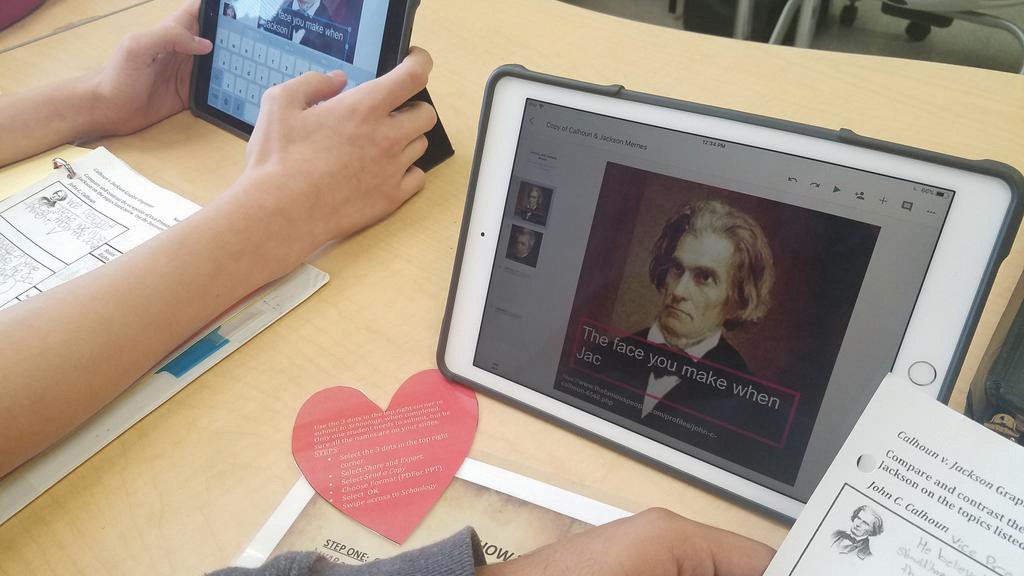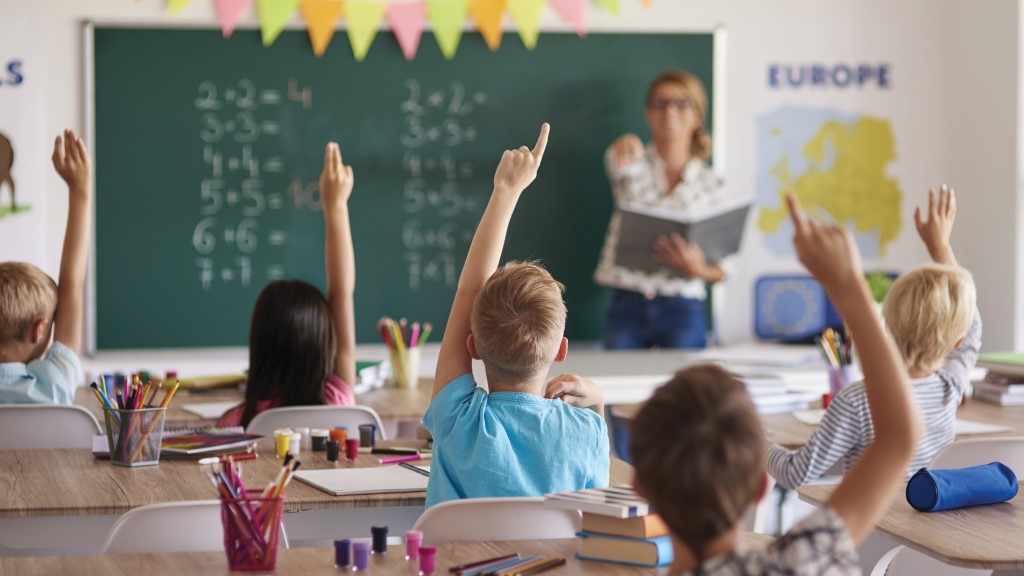When eighth-graders at South Carolina’s White Knoll Middle School created projects about their state’s nullification crisis over high tariffs, they used something they were all very familiar with—memes.
Previous classes, which had used traditional lectures, activities, worksheets, and videos to learn about the conflict between South Carolina and the federal government in 1832-33, had struggled to understand the importance of the dispute during Andrew Jackson’s presidency.
But when these eighth-graders were tasked with creating two memes—one to represent Jackson and the other to represent his vice president from South Carolina, John C. Calhoun—interest soared. They overlapped pictures of the men with adapted song lyrics and common meme formats such as “That look you give when…” to demonstrate each leader’s perspective of the conflict.
“It was a drastic shift” in comprehension, says digital learning coach Suzanne Brooks. “They ended up being really creative, and it seemed to take the content to a different level.”
This is exactly the sort of approach to teaching that resonates with today’s students—digital natives for whom engagement, according to research, is a serious problem stretching across racial, geographic, and socioeconomic lines.
Not even half of students who responded to a recent Gallup Student Poll—47 percent—are engaged with school. And while engagement is strong by the end of elementary school, it declines from fifth grade through roughly 10th grade, when only one-third of high school students report high levels of engagement.

Getting students to care about what they’re learning requires authentic and meaningful connections and collaboration, as well as choice and agency in the classroom.
Along with parental involvement, these factors contribute to better academic and personal outcomes. Gallup also found that engaged students are 2.5 times more likely to say they get excellent grades, as well as 4.5 times more likely to be hopeful about the future than their disengaged peers.
School districts certainly can find ways to increase student engagement—but the most successful efforts appear to be born from a quantifiable starting point. “It turns out that engagement is not just an elusive intangible,” says Sonya Heisters, director of partnerships and outreach for YouthTruth, a San Francisco-based nonprofit that works with schools and districts nationwide to administer anonymous school climate surveys. “It’s actually quite measurable, and we can measure it elegantly in a way that’s actionable for educators.”
‘Purposely plan' for change
YouthTruth can disaggregate data by grade level, gender identity, and student self-reported race or ethnicity, which helps educators target interventions where they’re needed most.
That means focusing less on “lagging metrics” such as attendance, grades, graduation rates, college placement, or acceptance rates, and more on real-world experiences, notes Heisters.
YouthTruth’s recent report, “Learning from Student Voice: Engagement,” analyzed online school climate and culture surveys administered across 36 states. While it shows that the majority of students feel engaged overall, only 48 percent of them in grades five through 12 feels that what they’re learning is relevant to life outside of school. And, as with the Gallup poll, the older the students, the less likely they are to feel engaged. In addition, the report found that only 52 percent of secondary students enjoy attending school most of the time.
Engagement soars when students are encouraged to work together toward a common purpose, are exposed to novel experiences, and understand how what they’re learning relates to their lives outside of school, according to Jimmie Walker, executive director of curriculum and instruction for Texas’ Alamo Heights Independent School District.
To do that successfully takes vision, strategic preparations, and a calculated execution, says Walker: “You don’t just wait and wish it happens. You have to purposely plan for it.”
Alamo Heights offers professional learning opportunities through the Schlechty Center, a Kentucky-based nonprofit organization whose mission is to increase engagement in schools.
As the district discovered, it pays to go straight to the source when trying to figure out how to combat complacency in the classroom. Students are surveyed about the level of engagement they feel with their teachers—a level that gets tracked over time and compared to a national norm sample.
“They know what they’re talking about,” says Walker. “They know what works with them.”
Technology as engagement tool
An effective way to make content more accessible, even fun: Technology, particularly the kind of high-quality, animated digital content Utica Community Schools uses to keep kids mentally stimulated.
“When a student gets stuck, there are immediate prompts or questions to make them think about their responses,” says Christine Johns, superintendent of the 27,000-student district, which is part of six communities in Macomb County, Michigan, and is the state’s second-largest school district. “It’s not unusual to walk into a classroom and see students giggling as they watch a short little video showing them how to do an instructional task.”
Children who learn at a young age how to set and reach goals become intrinsically motivated to continue learning, a benefit that carries forward into secondary, postsecondary, and professional life experiences, explains Johns.

Williamson County Schools in Franklin, Tennessee, found a way to make its 41,000 students more involved by putting them front and center in videos, published on YouTube, that celebrate good news, describe class projects, and spotlight issues such as vaping, cybersafety, and distracted driving.
Carol Birdsong, the district’s communications director, came up with the idea after watching how the television show “CBS This Morning” summarizes world news in 90 seconds.
Birdsong recalls: “I came in one day and said, ‘What if we could show, once a week, a clip of what every school is doing?’ Each one has a personality.”
A needed shift in focus
Teachers who keep things “new and fresh,” ensure that learning connects to the world beyond school, and model what it means to be vulnerable when learning, are going to best prepare younger generations for what’s ahead for them, says middle school teacher and project-based learning proponent Heather Wolpert-Gawron, author of Just Ask Us: Kids Speak Out on Student Engagement.
Yet she believes there’s still too much emphasis on end-of-year exams.
“It’s a strange mixed message we face as educators,” she says. “We know that we want to teach students how to communicate and be creative and be critical thinkers, and we’re still having them take standardized tests, which is really the antithesis of all that.”
For Geoffrey Thomas, superintendent of Madison School District 321 in Rexburg, Idaho, proof of an engaged student body has nothing to do with how well students perform on state standardized tests.
“I’ve never even looked at [the scores],” says Thomas, who is a fan of formative assessments in the classroom. “It’s an interesting modern-day paradox. By not focusing on achievement, we achieve.”
While Madison School District 321 has the highest reading scores in southeastern Idaho, which encompasses 14 counties, Thomas is talking about another form of achievement.
According to a 2018 survey conducted by the Idaho State Department of Education, the district, with about 5,400 students, is home to two of the top schools in the state when it comes to student engagement. At Hibbard Elementary, 82.1 percent of students were engaged; at Kennedy Elementary, 83.8 percent of students were engaged—the highest level of any public school in Idaho.
Promoting opportunities for more physical movement has been a key factor in boosting that engagement, says Thomas. In addition to extending recess from 15 minutes to 20 minutes and incorporating mid-morning exercises that include yoga or dance, transitioning more often between workstations during academic lessons keeps students more interested in what they are being asked to do.
And that makes things easier for educators.
“It’s an enormous waste of academic and mental energy when you’re pushing the principals to push the teachers to push the kids, and when does coercion really work in any society?” Thomas says. “On the other hand, with a warm, welcoming, energetic classroom, kids are naturally going to be more inclined to be engaged, teachers are going to enjoy their jobs more, and principals will have less stress because they'll be dealing with fewer behavior problems.
Frequent check ins and equity
At Katherine R. Smith Elementary School in San Jose, California, a greater emphasis on student engagement in K-6 grew out of an increased interest in restorative practices. At first, morning circles became a place to help build relationships with students while giving them a space to offload stresses and struggles. But administrators concluded that circles could be used in other contexts throughout the day.
“They have shifted beyond just an emotional check-in,” says co-principal Kevin Armstrong. “It could be, ‘What’s one thing you’ve learned?’ ‘What’s one thing you’re struggling with on our project right now?’ ‘What’s a goal you have when you come back in the morning?’
“When a school commits to using restorative practices and circles, it can be transformative [especially for students who are hungry or tired], but there has to be alignment that that’s a need and something you want to focus on,” he continues. “Reading and writing is obviously important, but it is really hard to get better at those things when you’re struggling so greatly.”
Parents also have a role in creating a highly engaged classroom. The National Coalition for Parent Involvement in Education reports that students with involved parents are more likely to have higher grades and test scores, attend school regularly, have better social skills, show improved behavior, and adapt well to school —no matter their family’s income or background.
What about students whose parents are not involved?
It is exactly that sort of question that leads to conversations about whether engagement initiatives to guide teachers should be more formalized—perhaps with an engagement standard on a national scale, suggests Wolpert-Gawron.
“When we talk about issues of equity, we know that every student deserves to be in an engaging classroom,” she says. “Regardless of their fundamental knowledge or lack thereof, every student deserves access to strategies that can help them remain curious as learners.”
Robin L. Flanigan (robin@thekineticpen.com) is a freelance writer in Rochester, New York. Her mindfulness-themed ABC/poetry book, M is for Mindful, was published in November.

Share this content